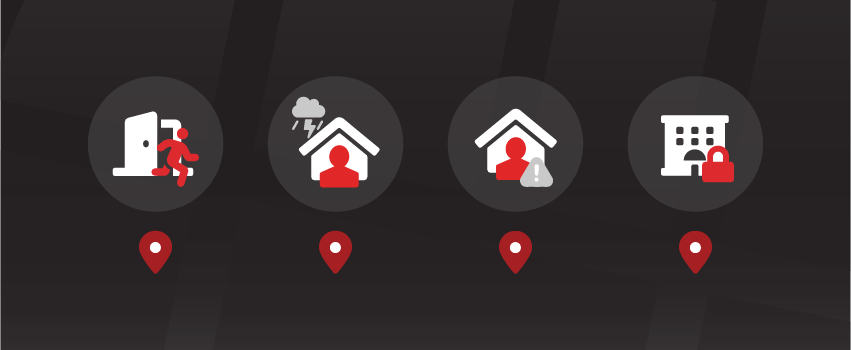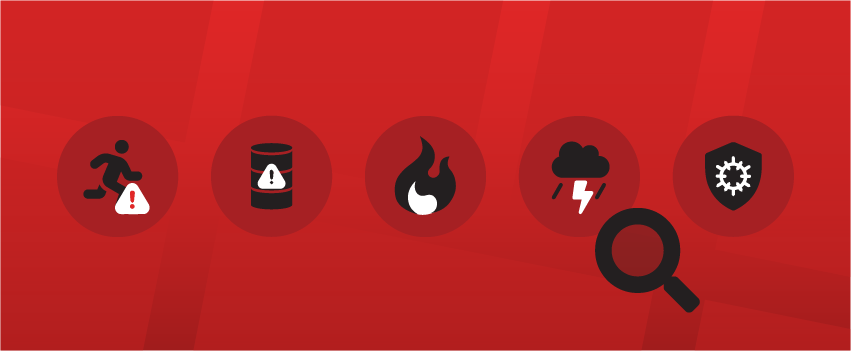Organizations face a number of potential risks every day, but proper preparedness is not always prioritized. Often, organizations believe that because they have never faced a certain incident before that they will not face it in the future.
Consider the below, though:
- From 2000 to 2018, there were 277 active shooter incidents, with 2,430 casualties, including 884 killed and 1,546 wounded (The Federal Bureau of Investigation)
- 76 percent of local governments report responding to a major disaster between 2000 and 2015, including hurricanes, tornadoes, floods, blizzards, and wildfires (Local Government Sustainability Practice)
- Since 1918, the world has experienced seven notable epidemics—including COVID-19—which all seriously impacted the human population (Healthline)
While the rise in active shooter incidents in schools prompted legislation and grant funding across the US for mandated school critical incident digital mapping and emergency preparedness planning, only 21% of the active shooter incidents from 2000-2018 occurred in educational environments. It is clear that a comprehensive, well-documented emergency preparedness plan is critical for all organizations to ensure they are ready to address any potential incident—from a natural disaster to violent threat.
Preparing for an Incident
No matter which industry your organization is in, there’s a risk of an emergency situation arising. You need to be prepared to address any potential incidents to help save lives, minimize economic losses, and mitigate property damages.
Your emergency plan should protect employees, visitors, contractors, or anyone else who may be in your building. OSHA acknowledges that organizations must consider the below when beginning to prepare for an incident:
- Conditions under which an evacuation would be necessary.
- A clear chain of command and designation of the person in your business authorized to order an evacuation or shutdown.
- Specific evacuation procedures, including routes and exits; post these where they are easily accessible to all employees.
- Procedures for assisting people with disabilities or those who do not speak English.
- Designation if any employees will continue or shut down critical operations during an evacuation.
- A system for accounting for personnel following an evacuation; consider transportation needs for community-wide evacuations.
Protecting the health and safety of everyone in the facility should be the first priority.
–The Occupational Safety and Health Administration (OSHA)
Each potential incident will require a different protective action that your employees should take to reduce injury and larger risk. The protective actions for life safety that should be integrated into your emergency preparedness plan include:
- Evacuation: Certain incidents like fires will require an evacuation, so organizations need to ensure that employees have a coordinated plan for exit points from the building; sufficient exits should be available and well-marked at all times.
- Sheltering: Events like severe weather can be unexpected, so companies need to evaluate potential shelters within the building—primarily the strongest areas of the structure—and hold drills so employees know where to go.
- Shelter-in-Place: Chemical or hazardous events require a distinct response from the surrounding buildings. Organizations need to ensure employees know to move away from windows, move to the core of the building, and avoid certain high-risk areas during hazardous incidents that are off-site.
- Lockdown: An active violent situation will require a quick, well-coordinated lockdown. Employees should know that when alerted, they need to seek refuge, work to barricade any entry points, and remain quiet.
Ensure that your emergency preparedness plan has the locations properly pinpointed so all employees will know where to go based on each distinct potential incident. It may also help to designate evacuation wardens who will help direct people into safe areas during an emergency situation; OSHA recommends one warden per every twenty employees to ensure a streamlined response.
To successfully build out a more formal plan, though, your organization will need to assess which incidents it’s most at risk of being impacted by.
Identifying Potential Risks
Your organization needs to complete a risk assessment to determine which potential incidents are most applicable. Because each workplace is unique, a thorough assessment of its setup and personnel will help identify which type of emergency situations could occur—helping build an accurate emergency action plan.
Below we outline some of the common emergency situations and some initial starting points for your organization to accurately prepare.
Active Threat Situations
An active threat situation is unpredictable and can rapidly develop into a large-scale problem. There are steps that organizations can take, though, to limit the risk to life, even if an incident unfolds. Your organization’s human resources personnel and department managers should lead the initiatives for developing an active threat plan—including working to create up-front processes that can limit long-term risk.
For example, senior-level employees should be trained to look for certain warning signs in employees, including:
- Inappropriate or aggressive behavior
- Numerous conflicts with other employees or supervisors
- Statements showing fascination with incidents of workplace violence
- Drug or alcohol abuse
- Extreme changes in behavior
While these actions don’t always indicate risk of more violent action, they can be a starting point for helping identify potential threats and mitigate the risk early on. Ignoring warning signs or ongoing concerns can result in an escalation of the problem—and larger risk of a more violent incident. It’s also crucial that all senior-level employees are empowered to address potential issues, including setting protocols for reporting issues and having them appropriately handled in a timely manner.
The above can’t eliminate the risk of an incident, however, so it’s crucial to pinpoint a comprehensive plan that all employees are trained on. In most active threat situations, your employees should know where to hide, how to barricade any entry points, and how to maintain quiet, including silencing all cell phones. By mapping out critical response protocols, your organization can begin the process of properly preparing for a violent threat incident.
Hazardous Materials
Regardless of what your business does, you are still at risk of a hazardous materials incident, including hazardous materials that are flammable, toxic, or radioactive. The source of this risk could come from within if you work at a hazardous materials facility—or it can be external if an incident occurs, like a local chemical plant catching on fire. Regardless of the source, your organization needs to be prepared to address any potential issues.
Involve representatives from multiple sectors to start building a comprehensive approach to a hazardous emergency response. The Federal Emergency Management Agency (FEMA) suggests that, as applicable, you should include representatives from:
- Maintenance
- Operations or line personnel
- Upper and line management
- Legal
- Fire and HAZMAT response
- Environmental, health and safety affairs
- Training
- Security
- Public relations
"One of the biggest gaps is not including local first responders into the planning process. Facilities need to take the time to include first responders in their planning to alleviate confusion if an emergency occurs."
–Rodger Norcross, former fire chief and law enforcement officer
You’ll want to ensure that all employees understand the internal and external hazardous risks. Facilities that have hazardous materials on site should communicate with employees on whether they should evacuate the facility or shelter in place should an emergency arise. If the need for an evacuation is determined, it’s critical to have documented areas where employees should go.
Fire
A fire prevention plan should be twofold: it should integrate ways to prevent fires while also identifying a response if a fire should occur.
OSHA identifies five classifications of fires that can impact varying organizations:
- Class A: Involves ordinary combustibles, such as paper, trash, some plastics, wood, and cloth; if it leaves an ash behind, it’s a Class A fire
- Class B: Involves flammable gases or liquids, such as propane, oil, and gasoline
- Class C: Involves energized electrical components
- Class D: Involves metal; if the name of the metal ends with the letters “um” (like aluminum or sodium), it’s a Class D fire
- Class K: Involves vegetable or animal cooking oils or fats; these are common in commercial cooking operations using deep fryers
Understanding which classifications of fire you are most likely to be at risk of can help properly prepare your organization while also adequately training any applicable employees. Discuss and review potential hazards with your local first responders so that they are aware of any on-site risks in case they need to respond to a fire at your organization.
In the event of a fire, an immediate evacuation to a documented location will help effectively protect employees; however, it’s integral that employees know their evacuation areas prior to a fire occurring. Prioritize training and make sure that all exit points are well-lit and accessible by all employees, including those with disabilities.
Natural Disasters and Severe Weather
Varying natural disasters and weather incidents can occur, so start by assessing which could actually impact your organization. For example, an organization in the Midwest needs to set criteria for disasters like tornadoes and flooding but ultimately can overlook planning for hurricanes or earthquakes.
Because some severe weather events can be forecasted in advance, a comprehensive plan can help your organization quickly prepare for the incoming disaster. Make sure that employees have clearly defined responsibilities for executing the response plan. If a severe weather alert is activated, it’s crucial that applicable employees immediately start guiding their colleagues to appropriate safety areas within the building or beginning an evacuation.
Your organization’s plan should also integrate processes for after the incident, including:
- Damage assessment
- Salvage
- Protection of undamaged property
- Cleanup
Having protocols in place following the incident can help to mitigate any further damage or economical loss.
Pandemics
Due to the unpredictability and complexity of pandemic situations, there are many considerations that are crucial to building a strong preparedness plan. A new pandemic situation can arise at any time, and continual adjustments to plans can help keep organizations and municipalities prepared for what’s next.
Preparedness for a pandemic varies drastically from the preparedness needed for other emergency situations, though, including natural disasters. The Pan American Health Organization (PAHO) identifies that a pandemic is different from a quick onset disaster because:
- The shock lasts six to twelve weeks versus a short duration.
- It takes place worldwide instead of a specific area.
- Help may not be available from neighboring countries or aid agencies.
- It involves a contagious disease, not a natural or manmade disaster.
- People should not seek public shelter because of risk of spread, so municipalities may not be able to provide emergency public shelter.
While an active pandemic situation may not be as common as other emergency situations, it is likely that COVID-19 will not be an isolated event. Keep your organization prepared by continuing to have conversations with relevant stakeholders, including local public health officials. You should also make considerations for which protocols will be implemented should another pandemic situation arise, including:
- Closing or limiting capacity to heavily congregated areas (cafeteria, waiting room, etc.)
- Enforcing mask mandates (if required by the Centers for Disease Control and Prevention)
- Establishing barriers between employees, as well as visiting clients or customers
- Creating traffic flow patterns in heavily utilized hallways
- Allowing for remote work (if your organization has the capabilities)
While these may seem like unnecessary conversations to continue to have, they are crucial for being prepared should another pandemic situation rapidly arise.
Remember: During any emergency, a disorganized preparedness plan can result in confusion, unnecessary injury, property damage, and economic loss—but a collaborative emergency preparedness plan can help mitigate these risks.
Investing in a Collaborative Approach
Collaboration is key when it comes to building a comprehensive emergency preparedness plan—no matter what type of emergency you’re responding to.
By getting all stakeholders to provide input and guidance, your organization will be better equipped to face potential emergencies. Often, though, bringing everyone to the table can be a challenge. That’s where StrataSite™ can help.
StrataSite is the only secure, cloud-based emergency preparedness planning tool that enables you to collaboratively create, deploy, and train on emergency response plans. This preparedness tool provides templates that help you plan for emergencies at a fraction of the time of traditional planning. These plans can also be updated with little time investment—providing flexibility to keep procedures updated and aligned with what your organization needs.
By investing in a collaborative, easy-to-update preparedness tool, your organization can continually adapt and evolve its plan to meet any changes or new needs.
Sign up for your free, no-obligation trial of StrataSite today.


